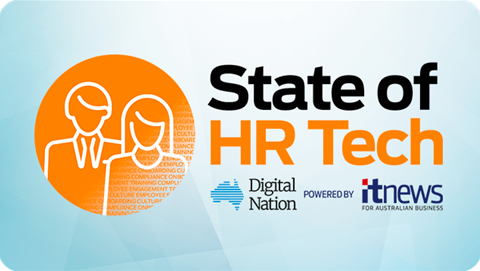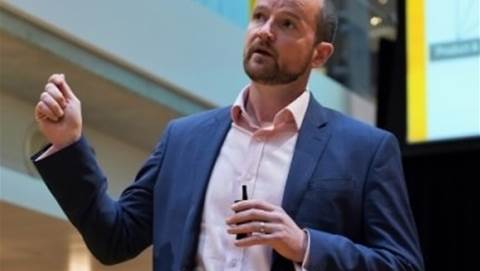When The University of New South Wales’ head of digital experience Martin Hoegh-Guldberg joined a year-and-a-half ago, he found 2400 “front doors into the university”.

Of those 2400 doors - websites - only 500 were “highly functional”. Some had up-to-date information, others didn’t.
“The faculties and divisions were like little villages unto themselves, and they had their own digital capability and marketing capability,” Hoegh-Guldberg recalls. “It was a very fragmented universe.”
It was hard to know where to look for information. The University (UNSW) also couldn’t join dots across its digital properties to understand who was looking and what they were looking for.
“Universities are incredibly competitive,” Martin Hoegh-Guldberg says. “Five years ago, you could sit there with a rigorous academic profile and have success [with] lots of students coming to you.
“While academic profile is an absolutely critical part for a university, we're now operating in a space where a lot of universities are competing quite hard for students and for high profile researchers and famous academics to drive their rankings globally.
“Students are getting three or four offers from universities. They're working out which one to take. How we can stay contextually relevant to a student who's considering Sydney, Melbourne, UTS and whatever else might be in their mix? We have to be far more front-and-centre with students in this day and age.”
UNSW is on a multi-year digital transformation journey, re-platforming all sites on an Adobe stack (and social channels to Hootsuite) to create a single view of the customer, whether that be student, academic, researcher, industry partner or other. Ultimately, it hopes to understand and predict behaviour - their next decision or move, and to deliver optimised and personalised digital experiences at scale.
Swinburne swings

Other universities are on similar personalisation journeys. Swinburne University of Technology, for example, rebuilt its own “digital foundations” to enable personalisation at scale.
“Digital transformation at universities can get complicated. We offer over 800 products in the form of courses, and these courses can cost a lot of money. It's a significant investment in terms of time, money and emotion for our prospective students, they have a lot of influencing voices - parents and teachers and friends, and everyone's got their own opinion as to the best university to go to, and the best course to study,” Swinburne’s senior manager of marketing analytics Nicole Austin says.
“The time taken from when our prospective student becomes aware of Swinburne and what it has to offer, through to when they're ready to make that decision and apply, can take anywhere from a number of months to a few years.”
Delivering the right information to prospective students at the right time makes all the difference.
“We want them to get to know us through the delivery of personal and connected experiences, so by the time they do get to the point that they're ready to make their decision, they feel connected to Swinburne and what we have to offer and they choose to apply with us.”
Kids these days

Educators from across the spectrum are also discussing - and implementing - more personalised experiences.
Students are digital natives, says UNSW’s Hoegh-Guldberg. “You really have to be communicating to them in the omni-channel fashion that they're accustomed to and where they actually engage with content.”
That content isn’t just to sell students on educational experiences; it’s about finding the best way to engage them to learn.
“It's all about each child,” says Greg Whitby, executive director of schools in the Catholic Diocese of Parramatta in Sydney’s west.
“But class is ... about command and control and order. It assumes that each child is the same. We get a curriculum, and we chunk it and we give it to everyone because they're all the same.
“The adults have taken command of the learning. And you know, as a learner yourself, what is the most powerful learning? When do you learn the best? When you take control of the learning. The reason we're trying new models is to put the learning back in the hands of the learner.”
Whitby has spent the past decade working on “a new theory base on which to build schools.”
“We have now a connected online world,” he says. “[But] you cannot say that learning is connected, contextual and meta-cognitive, and then do all the things that we see being done at the moment. It calls for a radical rethink.”
His own schools are “mutating early” to avoid what he believes will be a future rush. Schools under his watch are tailoring learning to individual students using data intelligence (and a suite of digital tools from the likes of SAP’s Qualtrics, Alteryx, Tableau and DataRobot).
Whitby says that proof of the need for change is evident in current absentee rates.
“Young people are voting with their feet,” Whitby says. “One of the biggest problems in schooling in [NSW] at the moment, and concern of governments, is attendance. On any one day, in some schools ... one-third of the students are outside having fun and enjoying themselves and running around being healthy - we hope they're doing that anyway. It's probably a better use of their time than sitting there listening to somebody stand up the front and tell them things that Alexa and Hey Google can tell them.”
Emerging "NGDLEs"

The Catholic Diocese of Parramatta ditched K-12 in favour of “pre-to-post”, covering early learning, primary, secondary and further studies.
“We're developing in that "post" area a whole range of new thinking about moving away from Vocational Education and Training (VET) into really demanding, dynamic courses that represent what you can do in the world today,” Whitby says. “Why would you go and do a TAFE credential when you can go to HarvardX … for free?”
Tertiary players are acutely aware of the growth in digital options - sometimes known by the acronym “NGDLEs” - next generation digital learning environments.
RMIT’s associate deputy VC of education, Professor Sherman Young, calls it a “technological challenge”.
“For universities, it's existential,” he says. “Why should our students come to us - because they don't have to. We make them go to school, they don't have to go to university, they can do all sorts of other things.”
Young tells the story of his son’s encyclopaedic knowledge of World War II facts at age 12. “He would sit there with his grandfather and regale the tank specifications and the tracks of the Tiger tank and the powerplants. He didn't learn that from books, from TV or libraries but from the online networked video game, World of Tanks. And he learned it. It didn't take a teacher in a classroom with a curriculum. He was engaged.
“How can we develop more meaningful engagement that actually improves the student experience and gets our students to learn because learning is the objective.”
Young calls out Minerva Schools as an example of the future education experience. “The model of learning is really interesting. Every undergraduate student spends a semester in Seoul, Taipei, London, Berlin, San Francisco, and Buenos Aires, so they actually move around, they live together, they learn the global cultures, they engage with a whole range of interesting experiences, and all learning formally is online,” he says, adding: “It's now harder to get into Minerva than it is to get into Harvard. It's a very attractive model.”
Accessibility

The use of digital to address disadvantage is also well understood.
The Australian Curriculum Assessment and Reporting Authority (ACARA) invited 160 schools with “a low index of community socio-educational advantage” to participate in government-funded workshops “to support the implementation of Digital Technologies subjects.” NBN Co performed research on digital literacy and its own role in bringing equitable access to education opportunities.
Personalised learning with digital technology can be used to increase accessibility and “foster an inclusive classroom,” says Owen Neal, head of ICT integration & technologies at Seton Catholic College in Perth.
At Seton, about 12 percent of students are on a curriculum adjustment plan or CAP - where the curriculum is modified to meet individual students’ needs. Those numbers are increasing.
The challenge for teachers was to “provide access to an equity in a curriculum to all students,” says deputy of teaching and learning Campbell Brown. “We worked with our educational psychologist and Owen and the IT team, and we've come up with some ideas.”
One of the ideas allows students with reading difficulties to use Microsoft tools like Immersive Reader and ReadAloud. Students can listen to a passage read to them and follow along; they can use it to check how something they’ve written sounds. If they struggle with writing, they can dictate into a microphone, have it converted to text, edit it, and have it read back to them.
It’s giving these students choices,” Neal says. “I think that's what technology has done for us now. But we have to get to the point where it becomes second nature and they use it without any prompts from us … where the students create their own learning experience rather than the teacher having to wander around and do that for them.
“For that to happen, we have to empower the teachers to be able to do that themselves. They bring it into the classroom, the kids pick up on that, and then we get to a point where the kids do it as second nature.”
Digital delivery at Melbourne High School

As schools seek to take advantage of new digital technology, they are also learning that they need to change their approach to IT infrastructure management.
Just look at Melbourne High School (MHS), an academically selective school that teaches more than 1,300 boys in Melbourne’s inner south. It has progressively overhauled its infrastructure to accommodate growing use of cloud services, such as Microsoft Office 365, Adobe Creative Cloud, the cloud-based learning management system Canvas, and the Compass student management system.
“In the last five years we have implemented a lot of change here,” says ICT manager David Ball.
“We are heading towards cloud because schools shouldn’t really have massive IT departments. Being a school is about delivering educational outcomes, and they should be able to consume all of this as a service.”
Ball’s ultimate goal is that network equipment and file-and-print servers are the only on-premises technology at the school. But getting there has meant dispensing with the residual acquisitions from decades of IT purchasing.
Dealing with legacy
In the past, cash-strapped schools often bought the least-expensive technology and sweated those assets until they simply wouldn’t turn on anymore.
So, when Ball arrived at MHS five years ago, he found servers with failing power supplies, network switches overloaded with cables, and storage arrays with questionable reliability figures that caused the network to fall over every few weeks.
“The problem with cheap and cheerful is that it’s a false economy,” Ball explains. “Over time you have issues with that stuff, and that’s been proven again and again.”
To address those issues, Ball committed to only buying enterprise-grade equipment, such as Brocade switches and Fibre Channel-based IBM storage area network equipment.
And to better support the new IT environment, MHS engaged hardware maintenance provider Interactive – its competitive pricing and responsive service team were key factors in that decision.
“With spare parts on hand and superior response times,” Ball says, “Interactive provide value that the vendors cannot compete with – so much so that we consult them before purchasing new IT equipment.”
“If Interactive don’t support the product, we keep looking.”
Reliability

Infrastructure upgrades have improved network performance and reliability, allowing MHS to invest more confidently in digital delivery without fear of outages.
MHS staff members are now working through the legacy environment to tackle “the invisible stuff”, Ball says. They are rationalising network patch cables and will eventually refresh the network to ensure robust end-user experiences, including for Wi-Fi and cloud users.
By focusing on learning outcomes while Interactive supports the infrastructure, the school has gained the confidence to adapt its learning environment.
“The network is the core IT asset here,” Ball explains. “When everything is Internet and cloud-based and you’re relying on it to deliver compelling educational experiences, you can’t have a network that falls over.”
“That’s why Interactive are a valued part of our IT strategy and we look forward to working with them to deliver for our students and staff for years to come.”



_(20).jpg&h=140&w=231&c=1&s=0)
.png&h=140&w=231&c=1&s=0)





 iTnews Executive Retreat - Security Leaders Edition
iTnews Executive Retreat - Security Leaders Edition












_(1).jpg&h=140&w=231&c=1&s=0)



